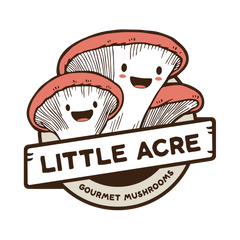OUTDOOR GROWING GUIDE
How to make mushroom garden beds
OUTDOOR GROWING GUIDE
How to make mushroom garden beds
Watch our how-to video
Growing edible mushrooms in your garden beds can be super easy and cost-effective. You don’t need any special equipment, just a shady spot, some mulch and a hose. Use sawdust spawn as your inoculum and watch our video tutorial which will teach you how to incorporate mushrooms into your backyard or garden in three easy steps.
Benefits of growing mushrooms outdoors
Mushroom garden beds are the most simple, fuss-free method of cultivating mushrooms. If you don't want to invest heavily into equipment or spend time building grow chambers the garden bed method is for you! The benefits of growing mushrooms using this method aren't just tasty - adding mycelium to your garden beds improves the quality of your soil and happy soil equals happy plants.
COST EFFECTIVE
No special equipment needed, just some inoculum, mulch and consistent water.
SIMPLE SET UP
Make a bed in three simple steps - mulch, inoculate, water!
GOOD FOR YOUR SOIL
Mycelium in your soil improves water retention and fungi share nutrients with your plants.
TO GET STARTED
Sawdust spawn
You'll need some mushroom culture to inoculate your mushroom beds. You can use grain spawn, but we recommend using sawdust spawn for outdoor cultivation. While grain spawn can work too, it's more nutritious (susceptible to contamination), doesn't spread as far, and it's more appealing to garden pests who might like to eat it - destroying your chances at mushrooms. It's important to note that not all species will like to grow in garden beds. We recommend starting with Wine Cap Mushrooms as they're best suited to this method. Oyster Mushrooms work well too but you can get better yields using the bucket method for Oyster Mushrooms.
SOURCING MATERIALS
Suitable substrates
The great thing about making mushroom garden beds is that you can source your substrates directly from your garden. Doing your annual pruning or have some freshly fallen branches that need mulching? You can use this hardwood mulch for your mushroom garden beds.
Wine Cap Mushroom like woody debris so small hardwood chips are an ideal substrate and you can mix this with straw or sugarcane mulch for quicker colonisation.
Oyster Mushrooms prefer straw or sugarcane mulch beds and will colonise and fruit much quicker than Wine Caps. Straw mulch or cane mulch from your local garden centre will work perfectly!
WHAT TO LOOK FOR
Identifying your mushrooms
Before picking any mushrooms growing outdoors it's extremely important that you correctly identify them. While unlikely, it is possible for other fungi (native or introduced) to sprout from your mulch beds and some can be toxic so best be sure if you're planning on cooking some up for dinner.
Thankfully, Wine Cap and Oyster Mushrooms are easily identified and we have a great guide below on their key features to look for when growing them in mushroom garden beds. If you're interested in foraging or identifying more species of fungi we highly recommend Wild Mushrooming as an excellent Australian-based guide.
WHEN TO HARVEST
Harvesting your mushrooms
You should harvest your mushrooms before the caps start to flatten out and turn upwards. Make sure you're keeping a close eye on your mushrooms once they start to grow as they double in size every day! Especially Wine Cap Mushrooms - they are super fast, ready in a flash (once you spot them, they'll be ready in just a couple of days).
As your mushrooms reach maturity you will see the edge of the cap turn upwards as it gets ready to release spores. The mushrooms will also start to fade in colour once they've matured. We recommend harvesting your mushrooms a day or two before they've reached full maturity.
Growth stages of Wine Cap Mushrooms
Wine Cap Mushrooms are some of the fastest growing mushrooms you can cultivate, blink and you'll miss them! Once your garden bed is about 8 weeks old if you have a heavy rainfall event keep a close eye on your bed as you'll likely get your first flush appear just 1-2 days after heavy rain or a good soaking with the hose. Wine Caps are best to eat when they're young. As they mature their caps will get giant and flat and once they start to spore their eating quality is reduced. We recommend harvesting them when the caps are still rounded or bell-shaped and the veil of the gills is still attached or just starting to fall from the cap. The images below show the difference in growth over just 3 days.
I can grow one more day but also ideal for optimum eating quality
Cap still rounded and good eating quality, harvest now
Quick! Pick me now before I spore and start to deteriorate
Mushroom Garden Bed FAQs
What is the best time of year to plant my Wine Cap Mushroom garden bed?
As this method of growing is outdoors you need to ensure you're choosing the right species for your climate and preparing your mushroom garden bed in the correct season. Download our free Seasonal Planting Guide.
Can I use pine woodchips?
No, pine is a softwood that has lots of antifungal properties and resins. The Wine Cap mushrooms won't like to grow on this type of wood. Use hardwood chips or sawdust from species such as Eucalypts or other flowering trees.
What if other mushrooms grow in my garden?
If you find that other fungi or mushrooms are popping up in your mulch bed, it's possible that these were present on the mulch already and have grown because your Wine Cap mycelium has failed to take off. If you have competitor fungi in your mulch bed you may need to get some new materials and start your bed again. If you're unsure about identifying mushrooms, send us a photo to hello@littleacre.com.au and we can help or consult a well referenced guide such as Wild Mushrooming. Never pick and eat a mushroom that you can't 100% positively identify!
Do I have to use all the sawdust spawn in one go?
For best results we recommend using all the sawdust spawn at once when you first open the bag. This will give you the best chance of success and prevent the sawdust spawn aging or contaminating after being opened. If you're not ready to use your sawdust spawn, store it in the fridge for up to 2 months.
When will the Wine Caps fruit from the bed?
The wine cap mycelium needs 8-12 weeks to grow in your mulch bed and establish. Once the bed is knitted together with thick layers of wine cap mycelium and it's been 8-12 weeks the Wine Caps will fruit after heavy rainfall. If you haven't had heavy rainfall and your bed has reached maturity, you can trigger fruiting by giving your bed or planter box a thorough watering.
Are there any pests that will want to eat the Wine Caps?
Yes. Common pests like slugs, rodents and possums will want to eat your tasty Wine Cap mushrooms. We recommend using some fine wire, shade cloth or netting to protect your mushroom garden bed once it is close to fruiting time. Bush Turkeys can also make a mess of your mulch beds!

